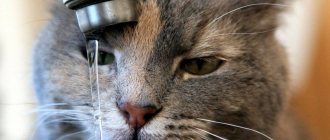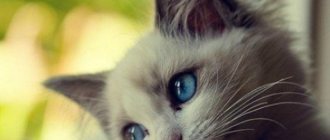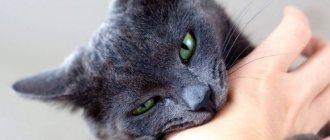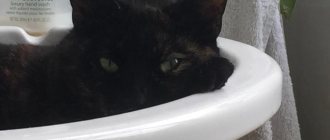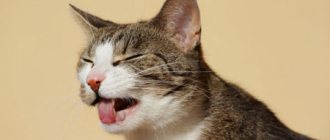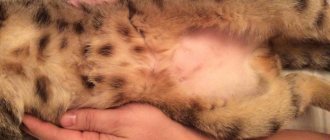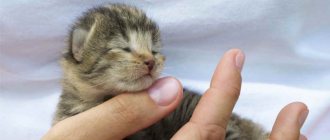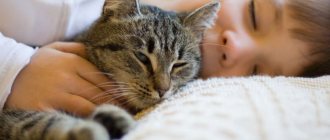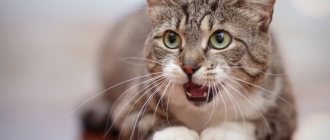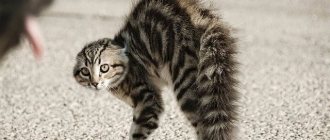Plastic bags are dangerous for cats for many reasons. If she chews them, there is a risk of choking and suffocation or developing an intestinal obstruction. Playing with plastic bags creates a risk of suffocation inside the bag or strangulation on its handles. Not every cat likes plastic bags, but if yours does, it's a never-ending battle in your home to keep bags out of reach.
For any given cat, there is one or more reasons why it loves plastic bags so much, but there are some of the most common reasons that we are finally learning:
— Plastic bags contain lubricating chemicals known as “glidants.” The chemicals contain stearic acid from animal fat. The gliding agent is designed to prevent the bags from sticking together. Some cats may be attracted to the taste and smell of these chemicals;
— To reduce the use of petroleum-based plastic bags, some companies use biodegradable bags made from products such as cornstarch, which may attract some cats;
- Plastic bags can be attractive due to the odors from the food that was stored inside, especially meat or fish;
- Texture is also something to consider. The smooth, cool surface may be attractive to lick or chew. What may have initially attracted the cat as an interesting resting surface may have later attracted the cat as an object for licking or chewing;
— The rustling sound of the bag may also be attractive to some cats.
The behavior associated with licking and chewing bags may begin because the cat does not have enough stimulation in the environment, and chewing plastic bags provides him with some activity. Cats that do not have sufficient emotional and physical stimulation and adequate play opportunities are more vulnerable to unwanted behaviors associated with boredom. Your cat may be left alone for too long.
For many animals, chewing or licking is a way to relieve stress. A cat that lives in a stressful environment may use plastic chewing as a coping mechanism. There are many other causes of stress that can affect cats that cat owners may not notice, such as a chaotic environment, changes in family composition, or changes in family members' daily routines, etc.
Reasons for cat behavior
Animals lick and chew plastic bags for several reasons:
- they retain the smell of food;
- soft polyethylene alleviates possible toothache or discomfort from inflammatory processes in the oral cavity;
- the material of biodegradable bags contains starch and fat, the taste of which the animal likes;
- the cat is attracted by the rustling sound;
- the animal is stressed or bored.
This is interesting: What breeds of curly-haired cats are there?
Soft polyethylene relieves toothache
Chewing may be a way to relieve pain. If a cat has dental or oral diseases, then it instinctively begins to lick or chew soft plastic bags, trying to get rid of pain.
In addition to dental diseases, other reasons can lead to the desire to “feast” on bags:
- state of stress (change in family composition, renovation, moving to a new place);
- poor nutrition;
- Digestive problems (hairballs stuck in the stomach).
Odor storage
And again we return to plastic bags. They are made from a polymer material, the gaseous hydrocarbon ethylene. These bags have the amazing property of absorbing all odors (especially the odors of the contents). For example, you buy food in a supermarket - fish, chicken, meat, etc. All this is wrapped in polyethylene. At the checkout, purchases are packaged in another, “large” branded bag. As you know, cats have a sensitive sense of smell. All the plastic packaging containers managed to become thoroughly saturated with food on the way home from the store. The logical result is the purr’s increased interest in the packages you brought.
How to wean a cat from a bad habit
Licking bags is far from a harmless activity for cats. During this process, the animal chews and swallows small pieces, which can lead to intestinal obstruction. You can prevent unpleasant developments in the following ways:
- limit access to cellophane: do not leave food in bags on the floor or table, close the trash can in the kitchen cabinet;
- Check the condition of your pet’s teeth and entire oral cavity with a veterinarian;
- buy toys so that the cat always has the opportunity to occupy himself;
- eliminate factors that cause stress in your cat;
- balance the animal’s nutrition, including all necessary vitamins and microelements in the diet;
- treat your pet with special chewing sticks with mint or matatabi.
Wild animals have access to various plants, with the help of which they normalize digestion and replenish vitamin deficiencies. Therefore, it is advisable for domestic cats to grow special grass in pots or containers. If you don’t have the desire or time to sow greens yourself, you can buy ready-made ones at the pet store.
If all the measures taken do not help wean your cat from the bad habit of licking plastic bags, you should seek help from specialists.
(3 votes, average: 3 out of 5)
Is it worth worrying
Situations when a pet eats inedible things happen often. There are a lot of reasons for this: from curiosity to nervous disorders. Usually food packaged in cellophane is distributed. A small piece will wrap around a food lump and leave the gastrointestinal tract naturally. You should worry if the foreign body is large.
The cat ate a plastic bag - alarming symptoms:
- weakness, lethargy, drowsiness;
- loss of appetite, refusal of water;
- prolonged vomiting attacks;
- regular diarrhea or constipation;
- tense abdomen, soreness;
- restless meowing, aggression.
All that is required of the owner is to monitor the condition and behavior of the pet. If nothing changes in 3 days, and the animal is active and eating well, then there is no need to worry. By the end of this period, the swallowed piece will be excreted along with the feces. If early signs of obstruction are detected, you will need to seek help from a veterinary clinic.
The cat is attracted by the rustling sound
The cat family has a special relationship with rustling and rustling sounds. This is due to the way they recognize moving objects at the time of danger or hunting. Therefore, the sound of rustling is a strong irritant for the pet. If a domestic cat lacks physical and emotional stress (they are provided by regular adequate games), then it tries to make up for this deficiency by licking bags.
Plastic bags pose a potential risk to the life and health of animals. Pieces of plastic can get into the respiratory tract and cause asphyxia (suffocation) for the cat. Their entry into the digestive system threatens the development of intestinal obstruction, in which emergency surgery will be required to save the life of the pet.
The use of plastic is gradually becoming an atavism for human civilization. In particular, when it comes to plastic packaging for products and more, many people understand the harmfulness of using such packaging. Plastic litters the earth and the world's oceans and slowly decomposes. However, there are more obvious harms to nature that many can see. It's about the nature of your home and the negative impact of plastic packaging on your cats.
Many cat owners know how much their pets love to lick bags, and sometimes chew and swallow. In general, there is little useful in this habit, but there is plenty of harmful. Therefore, you should figure out exactly why this habit occurs and how to wean your pet or domestic cat from licking bags.
How to stop playing with bags and licking
Although the factors considered are not supposedly about any pathologies in the body of cats, they can completely destroy these pathologies, and here the solution is clear - cats should be discouraged from chewing bags. Ant. accustom. For this purpose, quite understandable and accessible methods can be used.
- Do not leave cellophane in sight of cats. Just don’t create situations, sometimes cats can get to the plastic.
- Check your teeth. It is entirely possible that chewing is caused by some problem in the oral cavity. For that matter, you need to go to the vet.
- Buy exercise equipment. You know how small fry can sometimes play with a stick or mud and, as a rule, they do this not because of the special value of these substances, but because of the lack of an alternative. Cats also turn to chewing and rustling plastic casually for something more interesting. Therefore, buy exercise equipment for your pet with ladders and ropes, and the devil will most likely not remember playing with a plastic bag at all.
- Pay attention to the behavior of the animal. Cats can also get lonely, they look like such proud wanderers in this world, enjoying themselves as females, in reality they need your attention. Some time spent with a cat relieves stress, which can lead to chewing plastic, and is also a useful leisure activity for you that will distract you from everyday worries.
Either way, as soon as you notice a tendency to eat smoothly, you should find out the reason for this behavior, and eliminate the habit itself if possible. After all, we are not just talking about trivial order, but also about the health of your pet. From an overabundance of cellophane, the animal can simply die if this material ends up in the body.
When to see a doctor
A cat eats something inedible not always in front of its owner. Therefore, it is impossible to immediately discover what happened. You need to focus on your pet's behavior. Small, delicate things independently leave the body through the gastrointestinal tract. This usually takes up to 3 days. The cats do not show what happened in any way, eat well, and behave actively.
Alarming symptoms:
- increased salivation – due to blockage of the esophagus;
- cough, wheezing, blue tongue - when localized in the pharynx;
- restlessness, neck craning, hunched back;
- abdominal pain, bloating, accumulation of gases;
- lethargy, apathy, weakness, inactivity;
- vomiting with belching, problems with bowel movements;
- lack of appetite, thirst, exhaustion of the body.
The listed signs appear with the development of obstruction and damage to organ walls. If the condition does not return to normal within 3-4 days after the cat ate the money or hair elastic, the veterinarian decides what to do. The owner needs to get the pet to the clinic as quickly as possible.
This is interesting: Why do cats cry?
First aid
The surface of the tongue in cats has special papillae that are curved towards the esophagus. Because of this, they cannot get rid of the package that got inside. But under no circumstances should a person try to remove the bag from the cat’s body on their own. Any mechanical impact on the part of the owner can lead to damage to the intestinal walls or suffocation. The most that an owner can do at home is:
- Give the animal plenty of water to induce vomiting.
- To liquefy feces and facilitate the passage of a foreign body through the gastrointestinal tract, you can give your pet Vaseline oil.
- If a piece of packaging from a toxic substance is eaten, activated carbon or another adsorbent can be given along with a large amount of water to weaken the effect of the poison on the body.
It is important to remember that any first aid does not exclude consultation with a veterinarian. After all, it is unknown how many and what size pieces of polyethylene the cat swallowed.
When urgent veterinary care is needed. It is urgently recommended to take your pet to a veterinary clinic if:
- vomiting that does not stop for several hours;
- constant diarrhea or, conversely, constipation;
- changed behavior of the pet, restless meowing;
- licking the belly or rolling on the floor;
- swollen and painful stomach;
- lack of appetite;
- bloody vomit and feces;
- lethargy and apathy.
If such symptoms do not stop for a long time or appear 2-3 days after eating the bag, this is a serious reason to contact a veterinarian.
Why do cats like bags?
Cats lick plastic bags for a number of reasons.:
- The simplest option is that a plastic bag retains the smell of the product that was wrapped in it. In the case of meat and dairy products, the increased interest in used packaging on the part of curious pets is easily explained.
- Your cat may have tooth or oral pain. By chewing a soft bag, the pet tries to relieve discomfort.
- Biodegradable bags are made on the basis of starch; animals may be attracted by the smell, although it is imperceptible to humans.
- To prevent the bags from sticking together during storage and transportation, they are treated with so-called “sliding agents.” Typically, it is stearic acid, which is obtained from animal fat. In this case, a curious cat may be attracted by the smell of the bag.
- The structure of the bag is smooth and cool; in the warm season, the animal may simply enjoy lying on such a surface.
- The rustling sound can attract animals, especially kittens.
- Stress can cause your cat to become more interested in bags. If a pet is in an unfavorable environment and does not feel safe, then this may be the impetus for increased interest in cellophane.
- A cat or cat is trying to entertain itself. When a pet is alone for a significant part of the time or left to its own devices, the owners do not pay attention to it and do not play with it, then the animal very quickly finds a way to entertain itself.
Thus, a plastic bag as a toy is not a signal of the onset of pathological processes in the animal’s body, but banal loneliness or curiosity. In rare cases, this may be due to health problems.
"Play with me"
During their games, cats simply love to lick each other. By this, among other things, they say that they do not hold any stones to their hearts and completely trust their partner.
The exact same motivation drives our pets when they start licking a person.
If your cat licks your fingers, looks sweetly into your eyes and literally trembles with impatience, then most likely she expects reciprocity from you, wants you to play with him.
However, we humans do not often pay enough attention to our little ones and do not share their interests, in which case licking hands is the only thing left for the cat.
What to do if your cat plays with toilet paper
In this case, you can simply hang the roll higher or so that the paper does not hang down. If the cat has learned to rotate the roll, it is better to cover it with a special lid. You can also wean your cat off this fun by placing a small container of water or a tin with coins in it on a roll of paper.
Preventive measures
If a kitten or cat appears in your house, then you need to know what to do so that it does not eat the fish along with the cellophane.
- Do not throw away the skins of sausages, sausages, bags in which fish or meat was stored in places accessible to the cat. Keep trash bags out of your cat's reach. To prevent your cat from eating the skin of a hot dog or sausage, throw it away in a special bag that will be stored in an inaccessible place. Store used cat food bags there too;
- If there is a Christmas tree in the room, keep an eye on your pet. To prevent the kitten from eating the rain and tinsel, hang it high from the floor, do not let him play with it;
- Remove ribbons and threads, especially knitting ones, so that the cat does not eat them, especially if the day before you noticed that he ate a rag or paper;
- Do not allow the cat to eat a bag that smells of valerian, or blisters for sedatives that contain this herb. Cats often lick things that have come into contact with valerian and can swallow them.
Remember that your pet's health is in your hands. And his well-being, and in some cases his life, will depend on your vigilance and attentiveness.
Source
How to stop a cat from chewing and licking plastic bags?
Plastic bags can attract your cat because they rustle very pleasantly. Never allow your cat to play with them, even if he shows no interest in chewing or licking, so that he doesn't hear them rustling and you don't provoke unwanted behavior later. Keep all bags out of your cat's reach. Make sure everyone in the family knows the importance of this, so no bags are left in areas where your cat can reach them.
Switch to paper or fabric bags! This will not only help the ecology of the planet, but will reduce the risk of your cat getting injured from a stolen package.
Provide daily opportunities to meet your cat's emotional and physical stimulation needs to reduce boredom. Engage in one to two hour play sessions that allow your cat to locate, chase, pounce and capture her “prey.” Use a fishing rod toy to imitate the movements of your prey.
In addition to interactive play, your cat needs independent play, especially if she spends a lot of time at home alone. Use food puzzles for wet or dry food to keep your cat entertained throughout the day. Place several food puzzles in different places around the house to encourage your cat to play longer.
Provide an adequate environment for the cat. Your cat should have a cat set or other opportunity to rise above human height to play, relax and watch what is happening outside the window. In a multi-cat family, adding complexes and vertical territory can help maintain harmony and peace between the cats.
You should try to eliminate stress issues in your family that may be affecting your cat. If there are problems in the cat-to-cat relationship, work should be done to form healthier cat-to-cat relationships and peaceful coexistence. Make sure every cat has safe and easy access to resources. Look at how the feeding area is set up, how many trays you have and where they are located. Do cats have to compete for resources? Are any cats bullied by other cats? To effectively solve your plastic chewing problem, you first need to address the underlying causes of stress.
Any trash cans lined with plastic bags hanging on the sides should be stored in cabinets. Keep in mind that cats may be attracted to more than just plastic grocery bags. Don't leave plastic bags used to store food, such as lunch bags, on the kitchen counter.
Absolutely forbidden!
If you notice that a cat has swallowed polyethylene, then under no circumstances should you help him get rid of it. You should not give your animal drugs that cause vomiting or laxatives; the notorious Vaseline oil for cats is also highly taboo! This can significantly aggravate the situation and harm the cat. If you deliberately induce vomiting in a cat, there is a high probability of the bag getting stuck in the throat and, as a result, suffocation of the animal.
All laxatives and oils are dangerous because in case of intestinal obstruction, under their influence the intestines will become even more clogged and the pet’s condition will worsen. Self-therapy and attempts to alleviate the cat’s condition with intuitively selected medications, in many cases, end in an emergency visit to the veterinary clinic and the possibility of surgery.
If you are one of the lucky ones and everything is fine with the cat after such a feast, you shouldn’t rejoice ahead of time either. There is a possibility that when trying to go to the toilet, the animal may get this same polyethylene stuck in its anus. Under such circumstances, you should also not “help” the cat on your own. You should not try to pull on a piece of the bag that is visible to you; you can damage the mucous membrane and gastrointestinal tract of your pet. It is better to contact a specialist who, using special devices, will painlessly and quickly remove the foreign body from the rectum.
What will the doctor advise?
Even an ordinary Christmas tree ribbon can be deadly for a cat who decides to play with it. The material from which it is made may be more dangerous than polyethylene and cause severe intestinal obstruction, but the most dangerous are considered to be Christmas tree rain, ribbons for Christmas decorations, foil or rough paper. Therefore, for safety reasons, do not leave your cat unattended where there is a Christmas tree or bags of food or leftover food. If the cat has eaten cellophane, do not try to remove it completely, as this may damage the esophagus or a piece of cellophane will get stuck in the throat and may cause suffocation. You should not give a laxative, as it will worsen the effect; consult a veterinarian.
After examining the cat, he will prescribe an ultrasound and x-ray. These studies will help determine the localization of polyethylene and the general condition of the cat’s body. In some cases, a study with a contrast agent is required. If the animal has a severe case and necrosis of intestinal tissue has begun, surgical intervention will be required. If there are underlying medical conditions or if the cat is over 7 years old, this can be very risky, so it is worth preparing for any outcome. If the x-ray does not confirm intestinal obstruction, and the foreign body does not injure the internal organs, the doctor will most likely prescribe a diet. The cellophane will come out along with the stool.
If the package is stuck in the intestines, a rich and dense diet is required. Under no circumstances should you try to interfere with this process on your own, especially if the cat has eaten a large piece of a plastic bag. In this situation, it is better to contact a veterinarian. Even if a string is stuck in your cat's intestines, do not remove it as it may damage the intestines. It can pass out of the cat’s body with feces on its own, or this will require the intervention of a specialist.
Why does a cat eat inedible things?
Pica or perversion of taste or perversion of appetite is an irresistible desire to eat something unusual and inedible. Wikipedia
We are not always talking about true pica; in some cases, a cat’s interest in products that are strange from the owner’s point of view is understandable and normal. For example, many perfectly healthy cats love vegetables, even though they are not their natural food.
Pica in cats has not been fully studied and its causes are not always clear even to scientists. For example, when studying (1) a small group of cats with a compulsive desire to eat tissue, researchers found almost nothing in common between the animals except for various minor problems in the gastrointestinal tract. However, it is not entirely clear whether they were the cause or, on the contrary, a consequence of pica.
Relying on already known facts, we can say that most often cats try to eat or lick something strange:
- in case of certain diseases;
- if the item contains natural attractants (any fats, some isoprenoids; cats are also often attracted to the smells of valerian, alcohol, sweat, “bleach”);
- in case of severe nutrient deficiency;
- due to pain, physical or psychological discomfort;
- during the game (the excitement of the hunt);
The cause of pica is not always easy to determine. The human sense of smell is rarely able to detect traces of attractants (substances attractive to a cat), and the diseases that provoke pica are often subtle.
Many owners ignore the problem, relying on the false belief “The cat knows what is good for it.” This is not true. Natural regulators of appetite and food preferences exist (and sometimes fail!), but remember that cats evolved for thousands of years in the wild, where they simply did not encounter such an abundance of various chemicals as in the modern human home. Domestic animals live outside the conditions of natural selection and face completely different problems than wild animals.
Health
Perverted appetite can be a symptom of such serious problems as malabsorption of any etiology; anemia (including caused by pyruvate kinase deficiency); FIV (FIV, feline immunodeficiency virus); FeLV (feline leukemia virus); hyperthyroidism; diabetes; brain tumors; cognitive dysfunction.
Interesting
Just like people, older cats suffer from age-related brain problems. Cognitive dysfunction can cause pica and abnormally strong appetite, as well as other behavioral abnormalities.
Pica is not a funny quirk, but an alarming symptom that should not be ignored.
Nutrition
Proper natural feeding eliminates the possibility of primary nutrient deficiency.
Only extremely gross errors in diet preparation can lead to a deficiency of essential elements, for example:
- heat treatment of meat;
- no raw bones;
- absence of liver;
- poor diet, mono-diet of 1-2 products*;
- low fat diet;
- the use of cereals and a large number of vegetables.
If the diet is formulated correctly, nutrient deficiency can only be a consequence of problems with absorption (malabsorption), and not an actual lack of macro- and microelements in food. In this case, we need to diagnose the root cause, and not independently prescribe vitamin supplements to the cat. Malabsorption always indicates serious malfunctions in the body.
______ *May be acceptable if whole adult food animal carcasses are used.
Psychology
Sometimes eating and licking strange objects indicates stress and disorders such as OCD (obsessive-compulsive). It has also long been noticed that kittens that are taken away from their mother early, even in adulthood, tend to suck on soft things, as if returning to childhood, when they sucked their mother cat.
In some cases, begging for food, including food that is strange and usually unattractive to the cat, can be a way of communicating with the owner. Perhaps the cat is trying to attract attention and receive positive reinforcement in the form of a treat.
For psychological problems, good results are achieved by eliminating stress factors (if any) and regular high-quality enrichment (enrichment) of the cat’s environment.
Possible methods of enrichment:
- games, incl. with new and unusual toys;
- expansion of available vertical space (game complexes, shelves, stairs, etc.);
- food puzzles;
- light elements of training (learning tricks with positive reinforcement);
- walks on a harness.
All this significantly increases the cat’s psychological comfort.
If an animal has had a severe reaction to stress for a long time, increased anxiety, or signs of OCD, medication may be required (only as prescribed by a doctor).
Genetic and social factors
The tendency to pica can be a hereditary trait, although, as a rule, it is triggered by certain external events. It has been noted that pica is more common among cats of oriental breeds, although neither other breeds nor ordinary domestic cats are protected from it.
Interestingly, the eating habits of the mother cat influence what food the kittens will prefer in the future. Under experimental conditions (3), suckling kittens whose mother ate atypical food (bananas) subsequently also preferred to eat bananas rather than meat.
Play behavior
Stealing food is sometimes explained by the hunting instinct. A cat can eat inedible “prey” while still being in the excitement of the hunt, since for predators hunting and eating are inextricably linked.
Many cats like to play with small fruits: wild apples, cherries, cherries, grapes, strawberries... Some, while playing, squeeze the fruits in their jaws and accidentally swallow small pieces, which is incorrectly interpreted by the owner as a manifestation of gastronomic interest.
How it can be used
Confined space forces a cat to adopt a posture that helps keep it warm
The pet's attachment to boxes and packages can be used to transport a naughty pet to the required place or to fix the purr during weighing if the animal does not want to get on the scales on its own.
So, a cardboard shelter for a cat is not only a place of leisure, but also a way to convey your wishes to a person. Therefore, you should not be angry if your furry pet chose this particular object for his games.
What do you like about boxes?
In the eyes of a cat, a cardboard box can become a refuge or an object for play. Often cat owners use this packaging to create large play complexes. However, the cat does not necessarily need the box to be lined with warm material. If she likes it, it will be her favorite subject, taking up a lot of her free time.
The smell of childhood
Some believe that the reason for the interest may lie in the relationship between cardboard and wood. It is likely that the cat smells the native smell of wild nature. However, a more plausible version is her childhood memory: as a kitten, she was with her mother in a cozy box. And therefore he can remember the smell.
Why do they chew packages?
Plastic packaging attracts pets no less than cardboard packaging. There are times when a pet furiously tears a plastic bag with its teeth. This does not mean that he lacks any substances or is sick. Not at all: if you are sick, have a vitamin deficiency or feel unwell, the cat is not interested in the bag. The animal entertains itself this way, because, you see, the owner often pays too little attention to it.
The cat begins its play by rustling and often by tossing a package. While entertaining herself, she may give in to her predatory instincts, similar to those when she plays with a mouse. Other individuals like the way their claws dig into the polyethylene. If the cat seriously chews or even eats the bag, most likely there was something edible in it, which left an attractive smell for it. For the same reason, the cat licks bags.
Pica - “perversion of taste”
Some cats (we emphasize that they are a minority) happily eat completely inedible things and objects, including plastic bags. The generally accepted term in world medicine for “perversion of taste” is called “pica”. Experts and scientists are divided on the nature of pica. Some experts believe that pica manifests itself solely due to malnutrition; cats lack certain vitamins, elements or minerals. Others believe that pica is simply a consequence of early weaning of kittens from the mother's breast. Time will tell who is right; serious research is still ahead.
